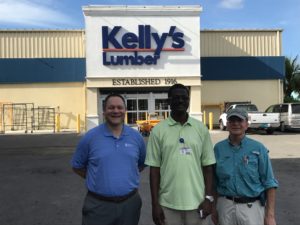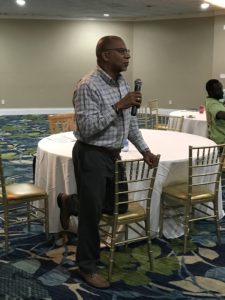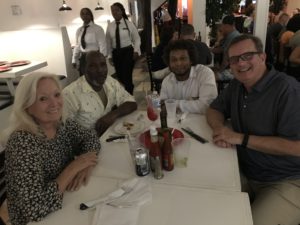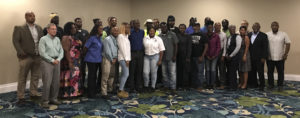
Code Council emphasizes safe wood construction in the Caribbean

Construction experts might not guess that the highest-volume export market for pine lumber grown in the southern United States is the Caribbean region, a group of more than 700 islands encompassing over a million square miles southeast of the Gulf of Mexico and home to nearly 44 million people. Last year, Caribbean firms imported over 337 million board feet of southern pine from the U.S., setting a new record. In just the past five years, southern pine lumber exports to the region have grown more than 50 percent.
That’s why the Southern Forest Products Association (SFPA) has been conducting a series of meetings, site visits and educational seminars throughout the region to educate builders, engineers, architects and lumber traders on how to properly select softwood lumber for various construction applications and why it’s important to follow local construction codes to ensure the wood is used properly.
Ron Piester, vice president of Membership/Certification at the International Code Council, accompanied SFPA representatives and industry experts on two week-long trips to the Caribbean to share information on how to safely construct wood buildings and learn about the issues facing building professionals in the region. The representatives visited construction sites and lumber trading companies to observe how wood is both stored and used and offered professional training seminars.
“With the increase in extreme weather events — hurricanes and wind events, primarily — that have affected the Caribbean islands, there’s some concern about the ability of buildings and structures to withstand the effects of a hurricane,” Piester said. “There’s a lot of misinformation down here, there’s a lot of misconceptions about how a wood-structured building would perform under wind conditions. Part of my role is to talk about how to safely construct a wood building, and what it means to comply with building codes and standards and to follow the rules of the regulatory system.”

As if to emphasize Piester’s message, just weeks after their visit to Nassau, the capital of the Commonwealth of the Bahamas, Hurricane Dorian — the most powerful cyclone to ever hit the islands — slammed through the region in mid-August, resulting 63 recorded deaths, causing an estimated $7 billion in damage and leaving at least 70,000 people homeless.
Piester said that one of the common refrains they heard from local lumber business owners was that it has been difficult educating buyers about the different treatments for wood used in above-ground applications compared with wood that comes in contact with the ground. This is especially important because of the widespread presence of termites and carpenter ants in the region.
The training seminar that Piester and the others gave in Nassau was attended by 42 importers, retailers, builders, architects and engineers. According to a report prepared by SFPA after the trip, the participants said they appreciated learning more about the U.S. lumber industry’s dedication to sustainability and quality.
“It showed me the importance of providing education right through the chain — from the building owner to the contractor, to the developer, to the architect and engineer, and to the supplier,” Piester said. “Educating all of those parties with respect to how the codes apply to not only the construction of a building but also to how each of the materials that goes into that building is evaluated, tested or identified as meeting the requirements of the code, is absolutely critical to creating a successful building project.”
While the International Codes (I-Codes) are not yet widely adopted in the Caribbean, the Caribbean Community, or CARICOM — an economic and development organization made up of 15 Caribbean nations and dependencies — is using the International Energy Conservation Code as the basis for a regional energy code that would be adopted by all member nations.

Piester said that building officials in the Caribbean are also learning about the International Building Code (IBC) by example. When a new major resort or hotel chain builds a new facility in the region, more often than not the designers and architects are following the IBC because that’s the code in force in the country where the chain is based.
“While the I-Codes might not be necessarily in place in the Caribbean Islands, there’s a tremendous amount of influence that the I-Codes are having on construction there,” Piester explained.
Softwoods are widely used throughout the Caribbean not only for building frames and roofs but also for decks, marinas and concrete forming. Piester said that as long as it is properly treated and installed according to building codes and industry best practices, softwood is just as reliable a building material in the warm, wet tropics as anywhere else.
“In the I-Codes, there are proven provisions that identify, for instance, how to protect wood from the effects of moisture and insects,” Piester said, “and how to construct a wooden structure so that it will withstand the impact of inclement weather.”
“While one might think that it’s better to construct a building out of concrete or steel, ultimately that’s the decision of the architect to determine based upon the program the client has presented, the budget they have to work with, application of the codes and other factors that go into planning and building a structure,” Piester said.
Related:
Caribbean Community Regional Organization for Standards and Quality presented with ICC Global Award
The Caribbean looks to Code Council for regional building code support
Reaching the Caribbean Islands
Caribbean Roadshow highlights partnerships
CROSQ releases energy efficiency standards
ICC Global Services regional strategy
Having completed visits to Trinidad, Barbados, Nassau, Grand Cayman, St. Maarten and Aruba this year, the Code Council and SFPA are discussing more trips to the Caribbean in the future to continue the dialogue with local building experts and sharing best practices.
“It was really interesting introducing the International Code Council to these groups, because most of the people we spoke with were just barely aware of the Code Council, if they had heard of it at all,” Piester said. “One of the things that was very encouraging to me was that people began to understand that the Code Council is a resource for people who want to build safe buildings and communities. We’re not trying to push ourselves on anyone, but rather we’re trying to help promote the success of our mission, which is to create safe buildings and communities. That started to open some eyes. I’m hopeful that with each visit here, we’ll be able to educate more and more people about the Code Council as a valuable resource to the Caribbean.”
The Code Council is working closely with the CARICOM Regional Organisation for Standards and Quality (CROSQ) to help the 15 member states in the Caribbean to adopt and effectively implement a new energy code. The CROSQ invited the Code Council Board of Directors to meet in person to cement its partnership and see first-hand the effects of its work in the region. In December, the Code Council Board of Directors will hold its first meeting outside of the United States in the Caribbean.








